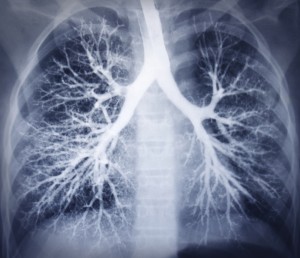 In a recent study titled “Protein Signature of Lung Cancer Tissues” and published in the PlosOne journal, a team of researchers used highly multiplexed proteomic technology (SOMAscan) to compare protein expression signatures of non small-cell lung cancer (NSCLC) tissues with healthy adjacent and distant tissues from surgical samples, discovering 36 proteins that had significant different expression patterns between tumor samples and healthy ones.
In a recent study titled “Protein Signature of Lung Cancer Tissues” and published in the PlosOne journal, a team of researchers used highly multiplexed proteomic technology (SOMAscan) to compare protein expression signatures of non small-cell lung cancer (NSCLC) tissues with healthy adjacent and distant tissues from surgical samples, discovering 36 proteins that had significant different expression patterns between tumor samples and healthy ones.
Understanding the differences between the human proteome of healthy and diseased tissues may provide invaluable information that could lead to the discovery of novel biomarkers, new targets for drug development and to the discrimination of which patients are more likely to benefit from different types of treatment. This is particularly important as early diagnosis of lung cancer is critical to successfully treating the disease.
SOMAscan is an affinity-based proteomic technology that allows the discovery of novel biomarkers and can measure more than 1,000 proteins from very small volumes of plasma or serum samples. It can then quantitatively measure proteins transforming them into the corresponding DNA signature.
This assay has already been proven to work in the measurement of several different proteins in studies of kidney cancer and lung cancer.
In this study the team analyzed lung tissue samples obtained from surgical interventions of 8 non-small cell lung cancer (NSCLC) patients who were smokers between 47 and 75 years old and had a diagnosis of NSCLC stages IA through IIIB. The analysis was extended to tumor tissue sample, adjacent non-tumor tissue and distant uninvolved lung tissue.
The signals generated by the SOMAscan technology had more similarities between adjacent and distant tissue. On the contrary, when tumor tissues and non-tumor tissues (both adjacent and distant) were compared, 11 proteins with greater than four-fold differences and 53 proteins with greater than two-fold differences were obtained.
Furthermore, the results identified 36 potential biomarkers between tumor tissue and non-tumor tissue. These NSCLC tissue biomarkers overlap with a previously identified core set obtained from a large serum-based NSCLC study, using the SOMAscan.
“Taken together, these data contribute to further understanding of the complexity of changes accompanying NSCLC and provide us with additional potential biomarkers for the early detection of this deadly disease”, the authors conclude in their study.


